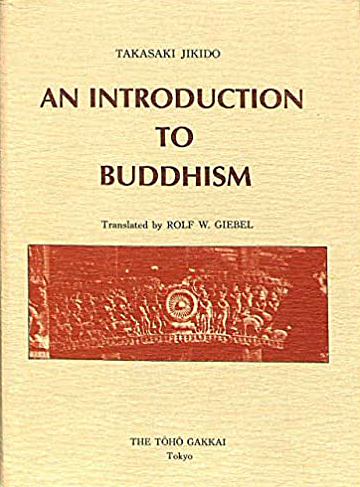- Preface to the English Versioniii
- A Note on Foreign Wordsviii
- Introduction: What is Buddhism?1
- Buddha, Dharma, and Saṃgha: The Three Constituents of Buddhism3
- Taking Refuge in the Three Treasures5
- The Absolute Nature of the Dharma8
- Mahāyāna and Hīnayāna: The "Greater" and "Lesser" Vehicles11
- The Buddhist Canon (tri-piṭaka)16
- I. The Life of Śākyamuni23
- The Buddha Śākyamuni23
- Biographies of the Buddha25
- Birth and Renunciation28
- Austerities and Enlightenment31
- The Beginnings of Śākyamuni's Teaching Ministry: His First Sermon34
- Dissemination of the Teaching and the Growth of the Community38
- The Great Decease42
- Erection of Stūpas and the First Council45
- II. The True Nature of the Buddha49
- Designations of the Buddha50
- Buddha and Tathāgata53
- The Former Lives of the Buddha55
- The Buddhas of the Three Ages59
- The Buddhas of the Ten Directions61
- Material Body and Dharma-Body64
- The Theory of Three Bodies68
- III. Dharma: The Buddhist Conception of Truth70
- The Meanings of Dharma70
- The Basis of the Teaching: Dependent Co-arising and the Four Noble
Truths76 - Śākyamuni's: Philosophical Position: The Ten or Fourteen Unanswerables85
- "Dharma-seals": The Watchwords of Buddhism89
- Saṃskāra and Dharma: The Dependently Co-arisen96
- Dharmatā: The Principle of Dependent Co-arising100
- The Conception· of Truth in Mahāyāna Buddhism104
- Supreme Truth and Conventional Truth105
- IV. Sarva-dharmāh: The Constituent Elements of Existence107
- The Classification of the Constituent Elements of Existence in the Early Canon: The Five Aggregates, Twelve Sense-Fields, and Eighteen Realms107
- The Sarvāstivādin Classification of the Constituent Elements of Existence:
The Five Categories and Seventy-five Elements114 - The Sarvāstivādin Theory of the Elements: The Elements Exist Eternally120
- The Mahāyānist Conception of the Elements: All is Empty126
- V. Transmigration, Karma, and Mental Defilements128
- Transmigratory Existence: The Three Realms and Six Paths128
- Karma137
- Mental Defilements141
- The Twelvefold Chain of Dependent Co-arising149
- VI. The Path to Enlightenment163
- Nirvāṇa and Enlightenment163
- The Mahāyānist Conception of Nirvāṇa168
- The Path to Enlightenment170
- The Noble Eightfold Path172
- The Three Disciplines: Morality, Meditation, and Wisdom174
- Faith and Practice188
- Practices for· the Welfare of Others191
- The Practices of the Bodhisattva: The Six Perfections193
VII. Mind: The Agency of Practice .. , .... :······ .. ···········198 No-self and Subjective Agency ................................. 198 Mind (citta, manas, and vijfiana) ........ : ...... ;: .......... 200 Mind-only and Cognition-only ................................. -205 The 'Innately Pure Mind arid the · . .Embryo of the Tathagata ............................... : .. : .. ; .................... 215 Enlightenment a:nd-Salvation.:.: ....•..... ·J ••• •••••••••••••••••• 223 VIII. The Ideal Practitioner ..............•..... , .................. 227 The Concept "Man" ............ '.,. ............................... 227 Ordinary Man and Holy Mari' ................................. 228 The Stages ,of the Bodhisattv:a ...•.. ; ............ :: ................ 233 "One V ehide" and "Three V hicles" .: ..................... 240 IX. The Precepts and the Organization of th, Community .246 The Meaning of Sa'T[l,gha ............... ;.; ..................... 246 The Organization of the Community ........................ 250 Community Regulations .......................................... 255 X The History of Buddhism .................................... 263 1. Buddhism in India and the Surrounding Lands ...... 264 The Basic Schism ..................................... : .... 264 The Mauryan Dynasty and Dissemination to Sri Lanka ................................................... 266 The Kushan Dynasty and the Northern Tradition of Buddhism .......................... .,-: ..... 267 The Characteristics of Schismatic Buddhism ...... 268 The Birth of Mahayana Buddhism .................. 269 The Madhyamika and Y ogacara Schools ......... 270 The Age of Esoteric Buddhism ........................ 272 Tibetan Buddhism .......................................... 275 The Southern Tradition of Buddhism ............... 277 The Revival of Buddhism in India .................. 278 2. Chinese Buddhism ............................................. 279 The Introduction of Buddhism ........................ 279 Buddhism Takes Root: The Period of the Northern and Southern Dynasties .................. 280 The Establishment of Chinese Buddhism: The Sui and T'ang Dynasties ...................... 283 Subsequent Developments ................................ 290 3. Korean Buddhism .................... : ...................... .' .. 290
4.Japanese Buddhism .......................................... 293 The Introduction of Buddhism and Prince Shotoku ..................................................... 293 The Sects of the Nara Period ......................... 294 The Tendai and Shingon Sects ........................ 297 The Rise of the Pure Land Teachings ............. 300 The Introduction of the Zen Sects .................. 301 The Nichiren and Ji Sects .............................. 303 Buddhism since the Muromachi Period ............ 305 Sources .................................................................. 309 Select Bibliography ................................................... 315 General Index .............................................•... -........ 325 Character Index· ....................................................... 352 The Author; the Translator ....................................... 375

